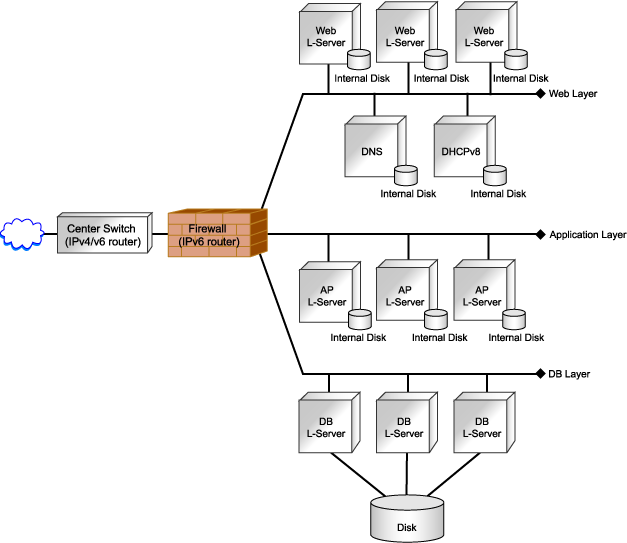When building an IPv6 network on a public LAN, the required network devices and settings vary depending on the desired operations.
Note
Resource Orchestrator does not provide IPv6 address management.
Address management should be performed by the infrastructure administrator and tenant administrator.
Network configurations that allow IPv6 packets on a public LAN to pass through the admin LAN to reach the admin server and managed server or units are not supported.
Operation | Required Network Device | Required Configuration |
|---|---|---|
Use of a static IP address to allow access from other servers. | None | Configure an IPv6 address for the server OS. |
Connects with the other servers as a client. | IPv6 routers | Set a prefix and the RA M/O flag on the IPv6 router. |
Use of the name published using DNS to allow access from the other servers. | IPv6 routers | Set a prefix and the RA M/O flag on the IPv6 router. |
DHCPv6 server | Register the DNS address on the DHCPv6 server. | |
DNS server | Configure the DNS server to enable connection with the IPv6 network. Configure the IPv6 address assigned to the server and domain name to be published on the DNS server. | |
Use of the name published using DNS to allow access from the other servers. | IPv6 routers | Set a prefix and the RA M/O flag on the IPv6 router. |
DHCPv6 server | Register the DNS address on the DHCPv6 server. Add an entry for the server identifier (DUID) and entries including the pair of the NIC identifier (IAID) and the IPv6 address to the DHCPv6 server. | |
DNS server | Configure the DNS server to enable connection with the IPv6 network. Configure the IPv6 address assigned to the server and domain name to be published on the DNS server. |
*1: When the IP address changes because of automatic IP address configuration performed by the server, the server may be temporarily inaccessible until updating processes for DNS cache, etc. complete. To avoid such a problem, use an automatic IP address configuration method that would not change IP addresses over time (such as EUI-64 or the OS specific method).
Information
In order to use IPv6 immediately after image deployment, perform the following on the collection target OS before collecting the image:
Enable IPv6
When there are manually configured IPv6 addresses, delete them
In Resource Orchestrator, an IPv6 network can be used for the public LAN only when using the following L-Servers:
Physical L-Servers
Virtual L-Servers (only for VMware)
For details on required configurations for individual devices, refer to the manual of each device.
Design of IPv6 Prefixes to be Allocated to Public LANs
An example of designing the IPv6 address range (prefix and network ID) to be allocated to each public LAN based on the assigned GUA is given below:
Assign prefixes in the unit of /64 for each network t so that automatic server configuration can be selected.
For three-tier models, assign /62 for the prefix length of each L-Platform, as this model requires four networks (three "public LAN networks" and one "network connecting IPv4/v6 routers and firewalls").
When performing static routing, configure routing settings on the IPv6 router. For details on how to configure routing on the IPv6 router, refer to the manual for the IPv6 router being used.
Figure 4.20 Example of Public LAN Configuration Using an IPv6 Network
